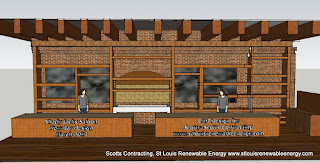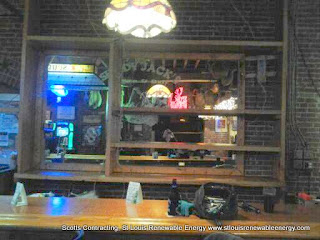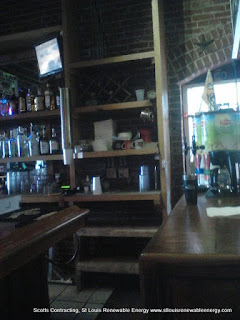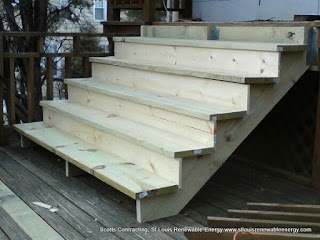- Put the Insulation on top of the roof eliminating any insulation in the cavities. As we talked about I feel that when the Insulation is on the outside is like a person having a coat on. It eliminates the hot or cold from entering.
- Commercial Buildings utilize this type of insulation to stop the cold/heat from getting to the steel, because when the steel gets hot or cold it expands/contracts and is a big energy problem.
- They also make this in tapered sections to direct water easily.
- Exposed Roof System for Aesthetic purposes
I used Menards for a guide. I suggest go to: the Roofing place at Vandeventer/44 area. The old RSG under new owners.
|
- Suggested R Value 25. Use 8 in Batt or Spray Foam Insulation. 8 Inch batt would be cheapest but not necessarily the best.
- Radiant Flooring systems warm the floor and the heat rises into the rooms. This also eliminates cold spots hvac fail to work in.
- The use of this may depend on the final floor choice selected. If it was going to be a tile floor I say yes. Maybe not a good idea if a finished wood floor is chosen-discussion needed. If you chose to install a concrete floor I definitely suggest a radiant floor heating system.
- For a total Green Aspect (but not $ viable suggestion) Exterior insulation would once again be suggested. Leaving you the option of utilizing the interior brick walls for aesthetic and old world design purposes.
- This same type insulation can be used on the inside but has to be covered to meet fire code. 1/2In Sheetrock.
- The Money saver is to build 2x4 framed walls with normal batt insulation and sheetrock. But you loose the kool looking brick look.
- This is a final design choice you have to make.
- Hot Water could be heated during the daytime easily with Solar. I suggest an instant type heater installed for use when needed.
- Liquid radiant flooring systems can be heated by Solar, tied into what ever system is used, or be independent with their own broiler system.
- Instant heaters without solar would require ½ the amount of pipes needed. Only one cold water pipe to the fixture is needed.
- I work with Dale Or and Suzie with “Master Plumbers StLouis” permits and as my go to person to call for advice.
- I would like to introduce you to Slim Shady, Shady Jack’s son. He is the one who built Shady Jacks and the 15+ bars they owned previously. He knows his stuff about building bars and these old buildings.
- Everything in your place is going to use electricity. Put in extra electric boxes or places to connect future lines.
- Along the same lines. Buying Energy Star Rated Kitchen equipment when you can is a smart investment.
- Upgrades to electrical motors and fans on commercial equipment qualify for discounts from Ameren UE.
- Using satellite imagery for determining roof size and using an electric bill of $400 / month. Solar PV would cover the 50% or up to $200 per month. $200 x 12 months = $2,400 yearly savings. 22 KW system
- Bill Size $500 Solar would cover 40%
- Additional Solar Panels could be installed on the West Wall of the Building- capture the afternoon sunlight.
- Additional Solar Panels could be used to create Open Air Spaces below where people could gather. See picture above.
- Pole Mount systems picture above in the background.
- I’ve considered many things for your building. The above suggestions would be my first choices and places that would save you money and create a green building to capture all the tax and other benefits available.
- I welcome further discussion about anything I’ve mentioned and also assisting you with the renovations.
- For detailed and specific estimates I need to see: blueprints, design notes, floor plans.
- I have Green Building Financing Resources that may work to your benefit they will assist in: Solar PV and Water, Energy Conservation, Windows, Doors, Insulation, etc.
Thank You for stopping by the Green Blog. If additional information in needed or you have a question let me know by posting a question or comment. Together we can make a difference and create a future that will benefit everyone.




















